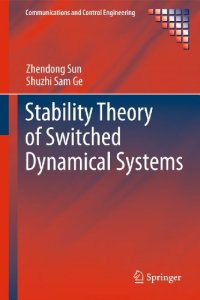
Ebook: Stability Theory of Switched Dynamical Systems
- Genre: Mathematics // Dynamical Systems
- Tags: Control, Systems Theory Control, Vibration Dynamical Systems Control, Probability Theory and Stochastic Processes, Linear and Multilinear Algebras Matrix Theory
- Series: Communications and Control Engineering
- Year: 2011
- Publisher: Springer-Verlag London
- Edition: 1
- Language: English
- pdf
Stability issues are fundamental in the study of the many complex nonlinear dynamic behaviours within switched systems. Professors Sun and Ge present a thorough investigation of stability effects on three broad classes of switching mechanism:
• arbitrary switching where stability represents robustness to unpredictable and undesirable perturbation;
• constrained switching, including random (within a known stochastic distribution), dwell-time (with a known minimum duration for each subsystem) and autonomously-generated (with a pre-assigned mechanism) switching; and
• designed switching in which a measurable and freely-assigned switching mechanism contributes to stability by acting as a control input.
For each of these classes Stability Theory for Switched Dynamical Systems propounds:
• detailed stability analysis and/or design;
• related robustness and performance issues;
• connections to other well-known control problems; and
• many motivating and illustrative examples.
Academic researchers and engineers interested in systems and control will find this book of great value in dealing with all forms of switching and it will be a useful source of complementary reading for graduate students of nonlinear systems theory.
There are plenty of challenging and interesting problems open for investigation in the field of switched systems. Stability issues help to generate many complex nonlinear dynamic behaviors within switched systems. The authors present a thorough investigation of stability effects on three broad classes of switching mechanism: arbitrary switching where stability represents robustness to unpredictable and undesirable perturbation, constrained switching, including random (within a known stochastic distribution), dwell-time (with a known minimum duration for each subsystem) and autonomously-generated (with a pre-assigned mechanism) switching; and designed switching in which a measurable and freely-assigned switching mechanism contributes to stability by acting as a control input.For each of these classes this book propounds: detailed stability analysis and/or design, related robustness and performance issues, connections to other control problems and many motivating and illustrative examples.